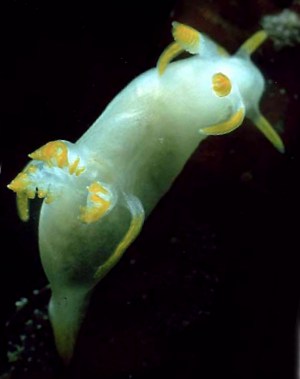
Trapania tartanella
(Ihering, 1886)
Order: NUDIBRANCHIA
Suborder: DORIDINA
Superfamily: ANADORIDOIDEA
Family: Goniodorididae
DISTRIBUTION
Mediterranean & nearby Atlantic coast
PHOTO
Isla Onza, Galicia, Spain - July 1978. Photo: Bernard Picton.
Note added 20 Sept 2007: This species and T. hispalensis are very difficult to distinguish externally and it is possible some identifications on the Forum are incorrect. See message #20698.
The body is translucent white with the brownish viscera showing through. The upper two-thirds of the oral tentacles, extra-branchial and extra-rhinophoral processes are yellow-orange, as are the rhinophore clubs. Usually the tips are a darker colour than the rest of the coloured regions. The white gills are also edged in yellow-orange. The radular teeth, as described by Ihering, are very similar in shape to those of Trapania fusca, with approx 17 small equal sized denticles and one outer denticle about 4 times as long.
-
von Ihering, H. (1886). Beitrage zur Kenntniss der Nudibranchien des Mittelmeeres, 2. 4, Die Polyceraden. Malakozool. Blatt. NF. 8: 12-48
-
Ortea, J. A., Quero, A., Rodriguez, G., and Valdés, A. (1989) Redescripcion de Trapania tartanella (Ihering, 1886) (Mollusca: Nudibranchia). Bollettino Malacologico, 25: 241-246.
Rudman, W.B., 2001 (February 10) Trapania tartanella (Ihering, 1886). [In] Sea Slug Forum. Australian Museum, Sydney. Available from http://www.seaslugforum.net/find/traptart
Related messages
Re: Second record of Trapania tartanella from the UK
August 31, 2009
From: David Kipling
Concerning message #22609:
Dear Bill,
I remember looking at this specimen underwater and initially thinking "Polycera faeroensis", based on its size and it being a white-with-yellow-bits nudibranch. It seemed a typical size for that species, and together with the scale of the red weed in the background I would guess this specimen is around 20-30 mm.
That isn't very large by tropical standards I grant you, but would be fairly typical for quite a number of the larger UK nudibranchs (aeolids and the like), as opposed to the harder-to-spot smaller ones like the Doto species.
Both Trapania specimens were easy to spot from several feet away; they were perched very visibly on contrasting red weed. However, they look so similar to Polycera faeroensis - a common and familiar nudibranch in the UK - that I wonder if other specimens have been seen but ignored as "just another Polycera".
Best regards
David
plankton@dircon.co.uk
Kipling, D., 2009 (Aug 31) Re: Second record of Trapania tartanella from the UK. [Message in] Sea Slug Forum. Australian Museum, Sydney. Available from http://www.seaslugforum.net/find/22623Thanks David,
Best wishes,
Bill Rudman
Second record of Trapania tartanella from the UK
August 27, 2009
From: David Kipling
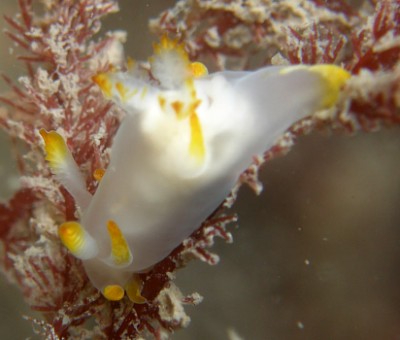
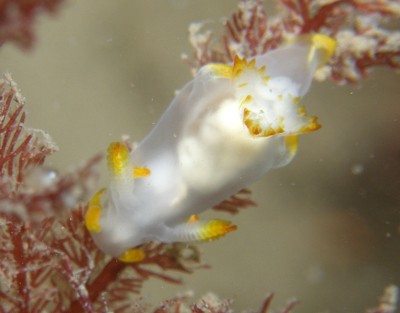
Concerning message #21913:
Dear Bill,
Sarah Bowen and I have now seen a second UK specimen of Trapania tartanella, this time further north. The location is a marine nature reserve on a westerly headland in Wales.
If larvae are coming in from the south (Atlantic coast of France and Spain) then the first landfall on the UK would be either Cornwall (where the first UK sighting was from), or if they land slightly further north then this is where Skomer is.
Locality: Rye Rocks, Skomer Island, Pembrokeshire, 15 m, United Kingdom, Atlantic, 9 August 2009, Sloping rocky reef with boulders, silty and weedy. Photographer: David Kipling.
What is curious is that Skomer is a very well-dived location because it is a marine reserve. Neither specimen was difficult to spot - a large white nudibranch with yellow markings, very visible on some seaweed. I wonder whether many divers do not recognise it as something interesting because it looks at first sight like a common UK species, Polycera faeroensis, and so ignore it.
Best regards
David Kipling,
Cardiff, UK
plankton@dircon.co.uk
Kipling, D., 2009 (Aug 27) Second record of Trapania tartanella from the UK. [Message in] Sea Slug Forum. Australian Museum, Sydney. Available from http://www.seaslugforum.net/find/22609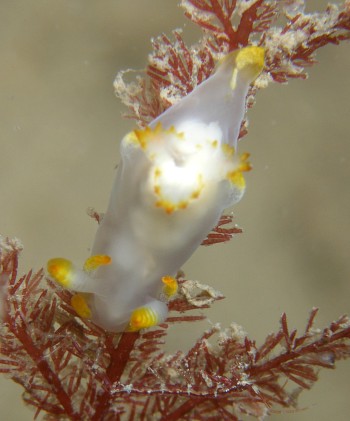
Thanks David,
You wonder why others don't see such an obvious nudibranch. Humans like most many sighted predators develop a 'search image' for their common or preferred prey. I have taken shell-collectors out to places they are very familiar with and been told "there are no nudibranchs here" only to find them everywhere much to the shell collector's amazement. What is obvious to you is often just not seen by people who don't know what to look for.
Can you give me an indication of size? You say 'large' nudibranch, but size, like visibility, is relative.
Best wishes,
Bill Rudman
Re: First record of Trapania tartanella from the UK
September 25, 2008
From: Juan Lucas Cervera
Concerning message #21913:
Dear David and Bernard,
I feel that this species is Trapania tatanella also
Best.
Lucas.
lucas.cervera@uca.es
Cervera, J.L., 2008 (Sep 25) Re: First record of Trapania tartanella from the UK. [Message in] Sea Slug Forum. Australian Museum, Sydney. Available from http://www.seaslugforum.net/find/21918First record of Trapania tartanella from the UK
September 24, 2008
From: David Kipling
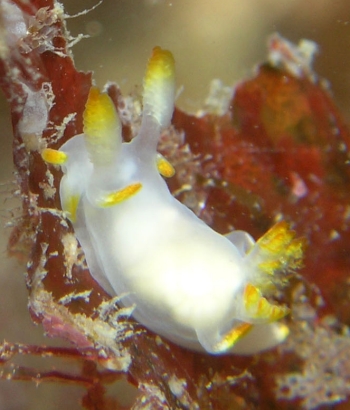
Hi Bill
Sarah Bowen and I saw the animal in the attached photo on a MCS Manacles dive last year. Pity I didn't take some more from better angles, but am I right in thinking this isn't a simple Polycera and could be something like Ancula gibbosa?
Dive site: The wreck of the Spiridian Vagliano, Manacles, Cornwall. United Kingdom. Map ref: 50º02.8 N 05º 02.7 W. 23 Sept 2007. It was about 10 m west of the wreck on an area of boulders and rocky outcrops, at a depth of 15-19 m. Photo: David Kipling
Although I took the picture, we don't recall who spotted it ... sometimes Sarah spots nudis and I then take the picture! This was Habitat 3 of the Surveyor record and other species recorded on this habitat included leopard spot goby, Cliona celata, encrusting sponges, star ascidian, crater sponge, dead men's fingers, purse sponge, fan worms, and squat lobsters. That gives a feel for the sort of environment we were in.
All the best
David Kipling
School of Medicine
Cardiff University
kiplingd@cardiff.ac.uk
Kipling, D., 2008 (Sep 24) First record of Trapania tartanella from the UK. [Message in] Sea Slug Forum. Australian Museum, Sydney. Available from http://www.seaslugforum.net/find/21913Hi David,
I've checked and I'm sure this nudibranch is Trapania tartanella. I've seen it in NW Spain (Galicia, Atlantic, 1978) and Sesimbra in Portugal, 2006. There is a similar species Trapania hispalensis, but it doesn't have the superficial orange pigment at the tips of the processes according to Juan Lucas Cervera. We'd really need to check the radula to be certain.
This is an interesting new record for the British Isles.
Best wishes,
Bernard E Picton
Bernard.Picton@nmni.com
http://www.habitas.org.uk/marinelife/
Picton, B.E., 2008 (Sep 24). Comment on First record of Trapania tartanella from the UK by David Kipling . [Message in] Sea Slug Forum. Australian Museum, Sydney. Available from http://www.seaslugforum.net/find/21913
Re: Trapania tartanella and T. hispalensis
September 20, 2007
From: Juan Lucas Cervera

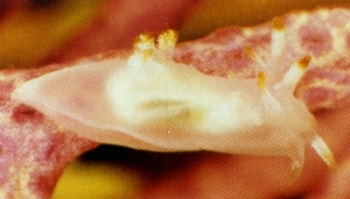
Concerning message #20685:
Hi Bill,
Several authors have found and recorded Trapania tartanella after its original description. You can find these records in the Introduction of the description of Trapania sanctipetrensis, as well as references to such records. One of them (Ortea et al, 1989) is a redescription of T. tartanella. The color plate included in the paper describing T. sanctipetrensis Cervera, García-Gómez and Megina, 2000, shows a picture of both T. hispalensis and T. tartanella. I have included copies of those picture here.
Upper photo: T. hispalensis, Straits of Gibraltar, Spain, 13 mm long. Lower photo: T. tartanella, southern Portugal, 6 mm long. Photos: J. C. Garcia Gomez.
I checked the radula of Portuguese specimens of T. tartanella many years ago and it matches Ihering's description.
I never found both species together, although the geographic distribution of both species overlap partially. In my experience, externally, in T. tartanella all the yellow areas show a superficial orange pigmentation at the tips, which is lacking in T. hispalensis. This is the only external difference that I have seen. In fact, when I collect the first specimens of T. hispalensis, I thought that belonged to T. tartanella. However, the radula differentiate both species very well.
-
Cervera J.L., Garcia-Gomez J.C. & Megina C. (2000) A new species of Trapania Pruvot-Fol, 1931 from the Bay of Cadiz, with remarks on other Trapania species (Nudibranchia: Goniodorididae). Ophelia, 52(1): 17-24.
-
Ortea, J. A., Quero, A., Rodriguez, G., and Valdés, A. (1989) Redescripcion de Trapania tartanella (Ihering, 1886) (Mollusca: Nudibranchia). Bollettino Malacologico, 25: 241-246.
Best.
Lucas.
lucas.cervera@uca.es
Cervera, J.L., 2007 (Sep 20) Re: Trapania tartanella and T. hispalensis. [Message in] Sea Slug Forum. Australian Museum, Sydney. Available from http://www.seaslugforum.net/find/20698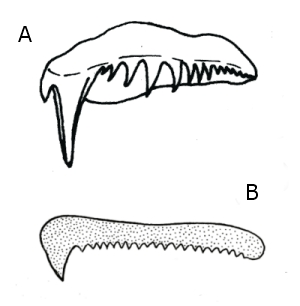
Thanks Lucas,
I thought it would be useful to add a couple of drawings showing the different shape of the radula tooth in each species. There seem to be two major subgroups within Trapania, one having teeth with a large outer cusp and then many much smaller inner denticles, and another group in which there are a number of larger cusps, some much longer than others, and a few smaller ones, each species being distinguished by the arrangement of larger and smaller cusps. These two species are an example of each subgroup.
A. Trapania hispalensis [from Cervera, Garcia-Gomez & Megina, 2000]
B. Trapania tartanella [from Ihering, 1886].
The paper by Ortea et al (1989) confirms the radular morphology of T. tartanella. It seems that almost all the animals I have on the Forum as T. tartanella are most probably T. hispalensis. Thanks also Lucas for permission to use photos of T. orteai and T. sanctipetrensis from the colour plate to prepare Fact Sheets for those two species.
Best wishes,
Bill Rudman
Re: Trapania tartanella from Peniche, Portugal
September 10, 2007
From: Juan Lucas Cervera
Concerning message #20641:
Dear Bill and Joao Pedro,
Be careful with this species. It could be misidentified with Trapania hispalensis Cervera and García Gómez, 1989. Checking the radula both species can be separated perfectly.
Best.
Lucas.
lucas.cervera@uca.es
Cervera, J.L., 2007 (Sep 10) Re: Trapania tartanella from Peniche, Portugal. [Message in] Sea Slug Forum. Australian Museum, Sydney. Available from http://www.seaslugforum.net/find/20685Dear Lucas,
Thanks for this reminder. Is there any actual difference in the colour between the two species? I note in your description of T. hispalienesis you mention the colour similarity between the two species but you don't mention any differences. Also has anyone looked at the anatomy of T. tartanella since its original description? I tried to find a recent description to compare the radula of the two species and the only illustration I can find is Ihering's from 1885(6). It would be nice to know there is an animal with this colour pattern with a radular tooth shaped as in Ihering's drawing.
- Cervera, J.L. & Garcia-Gomez, J.C. (1989) Dos nuevas especies de Trapania Pruvot-Fol, 1931 (Gastropoda: Nudibranchia) del sur de Espana. Boll. Malacol., 24(9-12): 189-204.
- von Ihering, H. (1886). Beitrage zur Kenntniss der Nudibranchien des Mittelmeeres, 2. 4, Die Polyceraden. Malakozool. Blatt. NF. 8: 12-48
Best wishes,
Bill Rudman
Trapania tartanella from Peniche, Portugal
September 8, 2007
From: Joao Pedro Silva
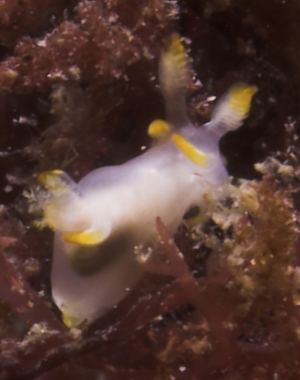
Dear Bill,
Here's a nudibranch [Trapania tartanella] I had only seen once before on a different dive spot (Baleal is 3km away from Peniche) so I hope I've identified it correctly.
Locality: Peniche, 8 metres, Portugal, North Atlantic, 01 September 2007, Rocky bottom. Length: less than 1cm. Photographer: Joao Pedro Silva.
Not from yesterday's dive but from the day before that on the same spot.
Cheers,
Joao Pedro Tojal Loia Soares Silva
jpsilva@uwphotographer.net
Silva, J. P., 2007 (Sep 8) Trapania tartanella from Peniche, Portugal. [Message in] Sea Slug Forum. Australian Museum, Sydney. Available from http://www.seaslugforum.net/find/20641Dear Joao Pedro,
I am pretty sure your identification is correct
Best wishes,
Bill Rudman
Trapania tartanella from Portugal
August 21, 2003
From: Joao Pedro Tojal Loia Soares Silva
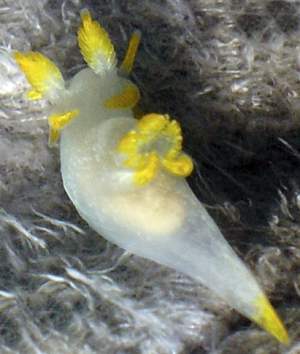
Dear Bill,
This was a lucky find. Inside a very small hole in the rock at about 6m depth I saw this very small nudibranch (it was less than 0.5cm long). In fact what I saw were two small yellow dots. I had to photograph it on the tip of my finger because my camera didn't fit the hole. I have no idea on what this may be.
It was shot in Baleal, Portugal.
All the best,
Joao Pedro
jpsilva@uwphotographer.net
Silva, J.P., 2003 (Aug 21) Trapania tartanella from Portugal. [Message in] Sea Slug Forum. Australian Museum, Sydney. Available from http://www.seaslugforum.net/find/10783Dear Joao Pedro,
This is Trapania tartanella. It seems to be a species we don't know a lot about, but as Bernard Picton illustrated in an earlier message, it feeds on minute animals called entoprocts.
Best wishes,
Bill Rudman
More Trapania food!!
February 12, 2001
From: Bernard Picton
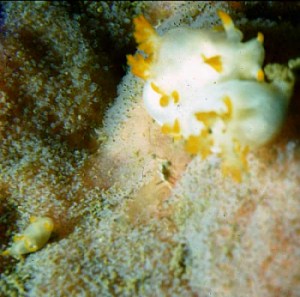
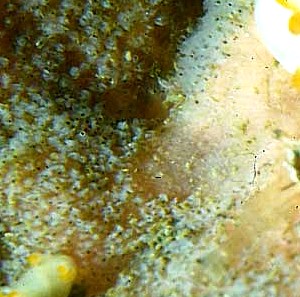
Hi Bill,
These are Trapania tartanella, also showing feeding on Entoprocts.
Isla Onza, Galicia, Spain - July 1978
Bernard
bernard.picton.um@nics.gov.uk
Picton, B., 2001 (Feb 12) More Trapania food!!. [Message in] Sea Slug Forum. Australian Museum, Sydney. Available from http://www.seaslugforum.net/find/3770Thanks Bernard,
I've included a close-up to show the entoprocts more clearly.
Bill Rudman
Trapania tartanella from Spain
February 12, 2001
From: Bernard Picton
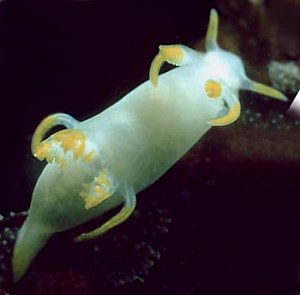

Hi Bill,
Here are some photos of Trapania tartanella, to accompany those showing it feeding on entoprocts.
Isla Onza, Galicia, Spain - July 1978
Bernard
bernard.picton.um@nics.gov.uk
Picton, B. , 2001 (Feb 12) Trapania tartanella from Spain. [Message in] Sea Slug Forum. Australian Museum, Sydney. Available from http://www.seaslugforum.net/find/3771Thanks Bernard,
Bill Rudman
